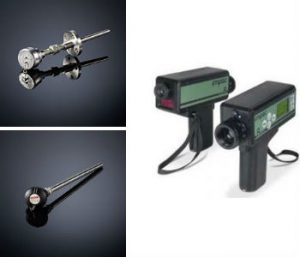 Infrared temperature measurement vs. contact temperature measurement: Which is right for your application?
Infrared temperature measurement vs. contact temperature measurement: Which is right for your application?
November 22, 2017 REDWIRE is news you can use from leading suppliers. Powered by FRASERS.
Posted by Thermo-Kinetics Measurement & Control Ltd.
For over 50 years, Thermo-Kinetics has stood out from the competition in offering the North American industry the best o... Read more
Subscribe
Free REDWIRE e-newsletter

Thermo-Kinetics offers both infrared and contact temperature-measurement tools.
When it comes to measuring the temperature of surfaces, there are only two options: infrared (non-contact) measurement and contact measurement. Both have their advantages, so it’s important to weigh the pros and cons of each to determine which is the most appropriate solution for the application.
Infrared measurement
Infrared thermometers are used for non-contact temperature measurement. They house optics that collect radiant infrared energy from an object and focus it onto a detector, which converts the energy into an electrical signal that is amplified and displayed. IR thermometers are strictly passive devices and have no impact on the measured product or piece of equipment. They can accurately determine an object’s temperature, even on small and fast moving objects, distant or overheated objects, as well as objects in hazardous environments. Other advantages include the ability to deliver measurement results within seconds, as well as their long service life (calibration may be necessary over time).
Contact measurement
For contact measurement, there are two options: resistance temperature detectors (RTDs) and thermocouples. RTDs measure temperature by associating the resistance of the RTD element with temperature, while thermocouples operate on the principle that when two dissimilar metals are junctioned and the junction is heated, they produce a low voltage proportional to the temperature. Thermocouples are used widely in many applications because they are very flexible and can be manufactured in more configurations than RTDs. They are also used in higher temperature applications (>600 degrees C) because they can withstand greater temperatures than RTDs; however, their service life is limited, as they can be prone to drift where the output changes over time, especially if the temperature is cycled. RTDs are slowly replacing thermocouples in many industrial applications below 600 degrees C. RTDs have higher accuracy, repeatability, low drift and a wide operating range. The downside, however, is that they are more expensive, less rugged, and configurations and flexibility are more restrictive than thermocouples.
A leading supplier
Thermo-Kinetics can supply RTD probes and assemblies, averaging RTDs, thermocouples and infrared thermometers from leading manufacturers. The company’s team of experts can help manufacturers determine which is the most appropriate solution for their specific application. To learn more, contact Thermo-Kinetics today.
Share
Posted by Thermo-Kinetics Measurement & Control Ltd.
For over 50 years, Thermo-Kinetics has stood out from the competition in offering the North American industry the best o... Read more
